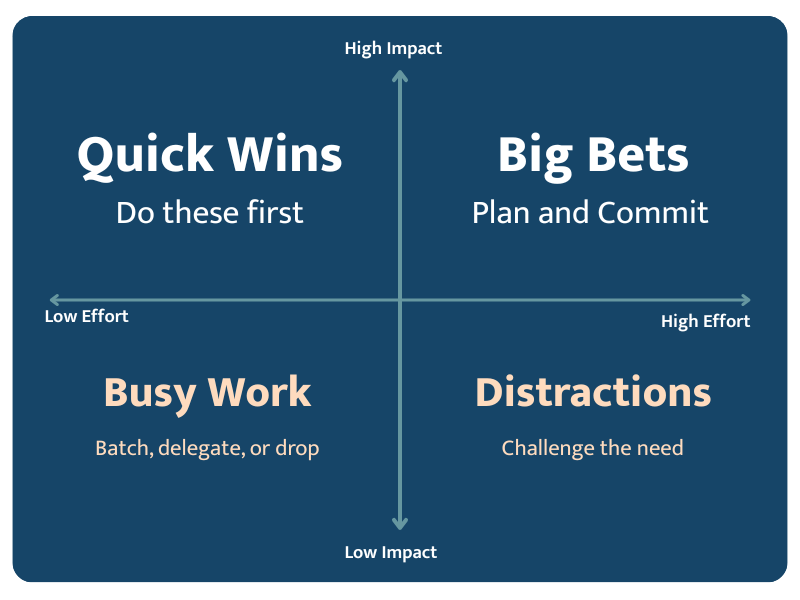How to Prioritize When Everything Feels Urgent in Marketing

Ever looked at your marketing to-dos and thought, “Where the heck do I start?”
Same. So did one of our clients—a powerhouse Communications and Fundraising Manager juggling everything from programs and events to operations and board meetings.
We delivered what we always do: a clear, confidence-building strategy across brand, digital, and content—the LeftTurn trifecta.
- Brand: We brought clarity to voice, story, and positioning.
- Digital: We aligned presence with purpose, making every touchpoint work harder.
- Content: We demonstrated how to connect with the right audience at the right time with the right message.
She took a breath, looked up, and asked the question we hear all the time:
“This is great… but what do I do first?”
That moment turned into a deeper conversation—and eventually, a framework.
Because the truth is, we’ve had that same exchange with founders, startups, marketing teams, and big-budget departments alike.
When everything feels urgent, it’s easy to panic-prioritize—doing a little bit of everything instead of the right things really well.
Let’s fix that.
The LeftTurn Method: 7 Ways to Prioritize Like a Marketing Pro
1. Start with Business Goals — Not Just Marketing To-Dos
Urgency is often a symptom of misalignment. Before tackling your task list, ask:
- What are your company’s top 3 priorities this quarter?
- Which of your marketing activities directly support those goals?
- What would actually make a measurable impact?
Marketing shouldn’t run parallel to the business—it should power it. Use business objectives as your filter and cut anything that doesn’t connect.
2. Use the “Impact vs. Effort” Matrix
When everything is labeled high-priority, use this to cut through the noise:

3. How to Evaluate the Options in Front of You
Not sure what to tackle next? Ask:
- Does this support a business-critical goal?
- What’s the risk of not doing this now—revenue, reputation, or just discomfort?
- What’s the cost of doing this instead of something else?
- Is this fuelling long-term growth or just busywork?
- Is the scope clear and realistic—or vague and ballooning?
Try a quick Priority Scorecard using 1–5 ratings for:
- Strategic relevance
- Time sensitivity
- Resources required
- Potential impact
Then stack-rank the totals. The real priorities rise to the top.
4. Limit Your “Active Projects”
Multitasking feels productive but usually leads to shallow work. Set a cap:
- 1 brand-level initiative
- 2 active campaigns
- 1 content project
Everything else? Backlog or parked.
5. Communicate Trade-Offs Clearly
Sometimes the issue isn’t priority—it’s pressure.
When someone says, “Can we get this out by Friday?” try:
“Here’s what we’re working on now. If this takes priority, we’ll need to shift something. Want to review the list together?”
This keeps you strategic, not reactive—and builds trust over time.
6. Build in Breathing Room
Urgency is often self-inflicted because we don’t account for:
- Reviews & approvals
- Content delays
- Fire drills from other departments
Add +2 days to every deadline. Block weekly time for cleanup, deep work, or strategy—not just output.
7. Don’t Be Afraid to Ask for Help
Small teams can’t (and shouldn’t) do it all.
That’s where partners like us come in—to give you structure, support, and breathing room. Whether it’s clarifying your roadmap, building a campaign plan, or helping you say “no” to the right things, we’re here to help you move forward with purpose.
✅ Cheat Sheet to Prioritize With Purpose
🔥 Start with Strategy
Align every task to a core business goal.
📊 Use the Matrix
Prioritize high-impact, low-effort work.
🧠 Gut Check Tasks
Ask: Is it essential, urgent, and worth it?
📉 Cap Your Capacity
Limit active projects to stay focused.
🗣️ Name the Tradeoff
Say what shifts when priorities change.
⏳ Build in Buffer
Add +2 days and protect deep work time.
🙋♀️ Ask for Help
Bring in support before you’re overloaded.
Final Thought
So next time you feel like you’re drowning in “we need this yesterday” vibes? Take a breath. Pull up this blog. And start with what matters most.
If your team is stuck in constant reaction mode, let’s talk.
You don’t need to go it alone—and the path to clarity might be just one left turn away.
👉 Book a free 30-min prioritization call and let’s make space for what really matters.

